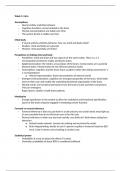Class notes
Special Topics in Neuropsychology
- Course
- PSYC 410
- Institution
- McGill University (Mcgillu)
Psychology : Developments in cognitive neuroscience and cognitive neuropsychiatry via readings from primary sources. Topics include the neural bases of memory, emotion, social cognition and neuropsychiatric diseases. Integrating knowledge from studies in clinical populations and functional neuroima...
[Show more]



